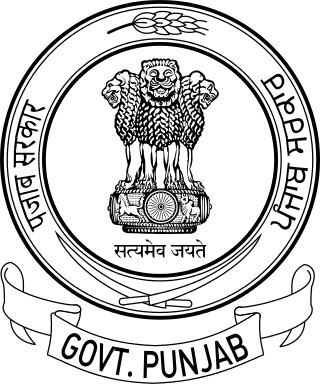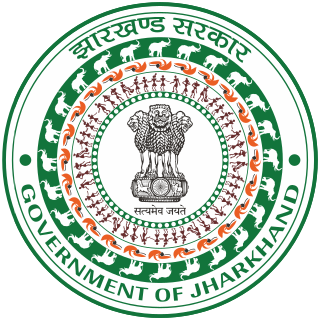
The State Emblem of India is the national emblem of the Republic of India and is used by the union government, many state governments, and other government agencies. The emblem is an adaptation of the Lion Capital of Ashoka, an ancient sculpture dating back to 280 BCE during the Maurya Empire. The statue is a three dimensional emblem showing four lions. It became the emblem of the Dominion of India in December 1947, and later the emblem of the Republic of India. The State Emblem of India is an official seal of the Government of India. It is used as the national emblem of India and appears on official documents, currency and passports.

Buddhist symbolism is the use of symbols to represent certain aspects of the Buddha's Dharma (teaching). Early Buddhist symbols which remain important today include the Dharma wheel, the Indian lotus, the three jewels and the Bodhi tree.

The royal arms of Cambodia is the symbol of the Cambodian monarchy. They have existed in some form close to the one depicted since the establishment of the independent Kingdom of Cambodia in 1953. It is the symbol on the royal standard of the reigning monarch of Cambodia, currently King Norodom Sihamoni.

The Ashoka Chakra is an Indian symbol which is a depiction of the dharmachakra. It is so-called because it appears on a number of edicts of Ashoka the Great, most prominent among which is the Lion Capital of Ashoka. The most visible use of the Ashoka Chakra today is at the centre of the Flag of India, where it is rendered in a navy blue colour on a white background, replacing the symbol of charkha of the pre-independence versions of the flag. It is also shown in the Ashoka Chakra medal, which is the highest award for gallantry in peacetime.

The Ashtamangala is a sacred suite of Eight Auspicious Signs featured in a number of Indian religions such as Hinduism, Jainism, and Buddhism. The symbols or "symbolic attributes" are yidam and teaching tools. Not only do these attributes point to qualities of enlightened mindstream, but they are the investiture that ornaments these enlightened "qualities". Many cultural enumerations and variations of the Ashtamangala are extant.

The dharmachakra or wheel of dharma is a symbol used in the Indian religions. It has a widespread use in Buddhism. In Hinduism, the symbol is particularly used in places that underwent religious transformation. The symbol also finds its usage in modern India.

The Lion and Sun is one of the main emblems of Iran (Persia), and was an element in Iran's national flag until the 1979 revolution and is still commonly used by nationalists and opposition groups of the Islamic Republic government. The motif, which illustrates ancient and modern Iranian traditions, became a popular symbol in Iran in the 12th century. The lion and sun symbol is based largely on astronomical and astrological configurations: the ancient sign of the sun in the house of Leo, which itself is traced back to Babylonian astrology and Near Eastern traditions.

The National Emblem of Sri Lanka is used by the State of Sri Lanka and the Sri Lankan government in connection with the administration and government of the country. The current emblem has been in use since 1972 and created under the ideas and guidance of Nissanka Wijeyeratne. At the time, he was Permanent Secretary to the Ministry of Cultural Affairs and Chairman of the National Emblem and Flag Design Committee. The designer of the emblem was Venerable Mapalagama Wipulasara Maha Thera, and the artwork was by S. M. Seneviratne.

Dhvaja refers to the Sanskrit word for a banner or a flag. Flags are featured in the iconography, mythology, and architecture of Indian religions such as Buddhism, Hinduism, and Jainism. They are one of the ashtamangala, the eight auspicious emblems of these religions.

Anegundi, previously called Kishkindha, is a village in Gangavathi, Koppal district, in the Indian state of Karnataka. It is older than Hampi, situated on the northern bank of the Tungabhadra River. Nimvapuram, a nearby village, has a mount of ash believed to be the cremated remains of the king Vaali.

The Emblem of Kerala is the official seal used by the Government of Kerala to represent the State of Kerala in all its official correspondences. The emblem portrays two elephants guarding the state emblem of India and the Shankh of Sri Padmanabhaswamy according to the history of Kerala.
At present there is no official flag for the state of Karnataka in India. However a number of historical and cultural flags have been used in the state.

The Lion Capital of Ashoka is the capital, or head, of a column erected by the Mauryan emperor Ashoka in Sarnath, India, c. 250 BCE. Its crowning features are four life-sized lions set back to back on a drum-shaped abacus. The side of the abacus is adorned with wheels in relief, and interspersing them, four animals, a lion, an elephant, a bull, and a galloping horse follow each other from right to left. A bell-shaped lotus forms the lowest member of the capital, and the whole 2.1 metres (7 ft) tall, carved out of a single block of sandstone and highly polished, was secured to its monolithic column by a metal dowel. Erected after Ashoka's conversion to Buddhism, it commemorated the site of Gautama Buddha's first sermon some two centuries before.

The Emblem of Uttarakhand is the official state seal used by the Government of Uttarakhand and is carried on all official correspondences made by State of Uttarakhand. It was adopted by the newly formed Interim Government of Uttarakhand at the establishment of the state on 9 November 2000.

The Emblem of Himachal Pradesh is the official state seal used by the Government of Himachal Pradesh and is carried on all official correspondences made by State of Himachal Pradesh. It was adopted by the Government of Himachal Pradesh at the establishment of the state on 25 January 1971. The State of Himachal Pradesh has an Emblem consisting of a mountain ridge over three white fesses, charged with the Aśoka capital.

The Emblem of Punjab is the official state emblem of the Indian state of Punjab and it is used as the official symbol of the Government of Punjab.

The Emblem of Jharkhand is the official seal of the Government of the Indian state of Jharkhand, officially adopted on 15 August 2020.

The Emblem of Haryana is the official seal of the Government of the Indian state of Haryana.






















